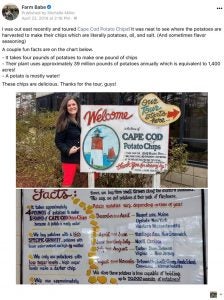There’s no question that it’s easy to get overwhelmed in the grocery aisle, with the array of colorful food packaging, big bold lettering, and “natural” and other labels, not to mention being swayed by advertising we may have seen on social media or television for each product. How does a food product stand out — ethically and meaningfully? I know that there are certain labels that I avoid because they’re misleading or have been co-opted to suggest they’re something they are not, and I’m sure that many of you out there have foods you avoid for specific reasons.
I usually like buy what tastes good and the fewer labels on the product, the better. I also avoid brands that throw farmers under the bus. We are so fortunate in our first-world country, and farmers deserve a ton of respect and praise for that, yet they often times feel undervalued and forgotten. Any farmer can do a great job regardless of size or label, so if a brand tries to paint a different farming method in a negative light (grass-fed ripping on grain fed, for example) I purposely won’t buy it. And I know I’m not alone with this train of thought.
So, I often wonder, if food companies used creative, positive, and forward-thinking methods to market their products instead of too many buzzword labels, would they be better off? In my opinion, it’s a resounding YES.
Here are six ways food companies can and should market their products to be original:
1. Humor! As a carrier of a Geico insurance policy, I must admit I’m a huge sucker for their commercials as they always make me laugh! Who doesn’t like to laugh? It would be great if more food companies used that to their advantage … like this brand of bacon. Hilarious? Shut up and take my money!

The pictured packaging originated with Black River Meats of North Springfield, Vermont. Credit for it goes to Sean Buchanan, Vice President of Sales and Marketing. I mean, really, what is this world coming to if we don’t know how to cook bacon? The photo has gone viral.
2. Farm tours. Everyone wants to know where their food comes from, so what better way to do that than through regular tours and transparency? A good example of this in my opinion is Cape Cod potato chips. Their factory is always open to the public with regular walk-in manufacturing visits at all hours of the day in Barnstable, Massachusetts. They include fun farm facts about potatoes and show the process from start to finish, with a gift shop at the end to purchase their products. I went, and below is some of what I learned. Now when I’m at the grocery store, their products jump out at me because I feel a connection to them tied to memories with my friend who I went with.
On the flip side, unfortunately I still won’t purchase Cape Cod chips because they use the Non-GMO Project label. At least on the tour, I was able to voice my opinion on this and why this label should be removed. Hopefully over time with more people explaining this, maybe they’ll remove it someday? I hope so, because I would love to buy them. Props for the tour anyway.

3. Tell a story. Who doesn’t love feeling a connection to where their food comes from? What if you knew exactly how it was grown and harvested or if part of the proceeds went to charity? What if a food brand was actively fighting hunger or donating to families in need? The Idaho Potato Commission in partnership with Lighthouse spice brand is currently doing this, donating $500 gift cards to families who have negatively been impacted by COVID-19. And good for them, I will actively look for the “made in Idaho” potato seal after knowing about their positive impact.
4. Buy local! What does local mean to you? For some, “local” may mean the United States, particularly when it comes to the misleading country of original labels (COOL) in the beef world. For others, “local” might be their farmers market. Regardless, when buying from a farmer directly, you can ask questions and get to know the face behind your food. You can probably tour the farm, keep dollars in your community, support the “little guy” and help keep them profitable and active. It also usually tastes better when fresh and in season. Granted we can’t always buy local (I like bananas in Michigan in January!), but if possible, it’s a great way to connect consumers to your product. One company that helps with this is Barn2Door.
5. Work with celebrities or influencers. Got milk? I know I do, especially in the ’90s with the milk mustache and “Got Milk?” campaigns. The dairy industry had every celebrity under the sun to make milk cool! I remember thinking how much I wanted to drink milk because I wanted to grow up beautiful, strong, and healthy like supermodel brand ambassadors like Tyra Banks.

Advertising nowadays has gone largely digital, and online influencers play an important role. Whether working with celebs or influencers with a large following, partnering with them can be a major influence in brand awareness to boost sales.
6. Promote farmers! Food companies like Domino’s pizza and Culver’s restaurants do a great job highlighting the work of farmers. They thank them, donate money to programs like FFA and start campaigns to help the industry. Positivity works and certainly can’t hurt anything.
Michelle Miller, the Farm Babe, is a farmer, public speaker and writer who has worked for years with row crops, beef cattle, and sheep. She believes education is key in bridging the gap between farmers and consumers.



